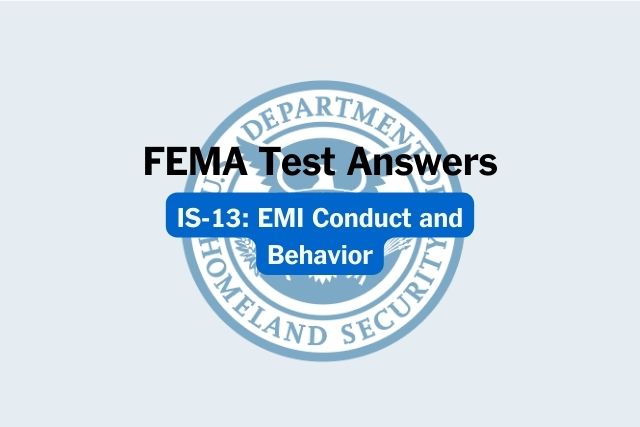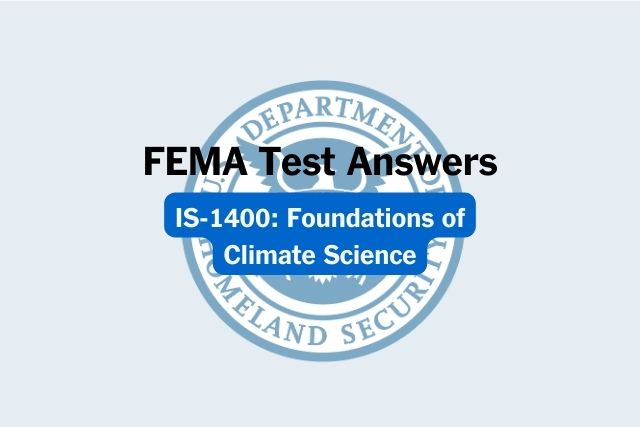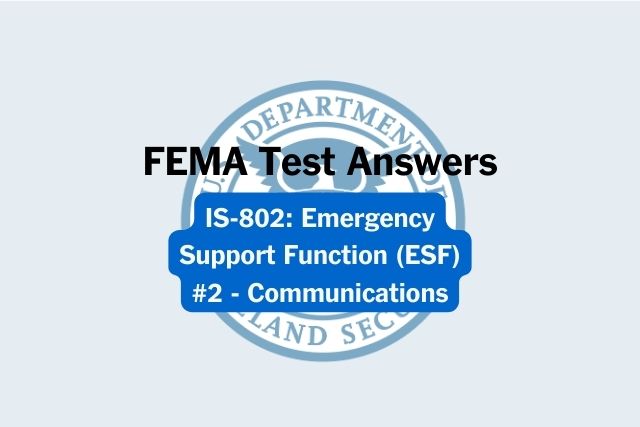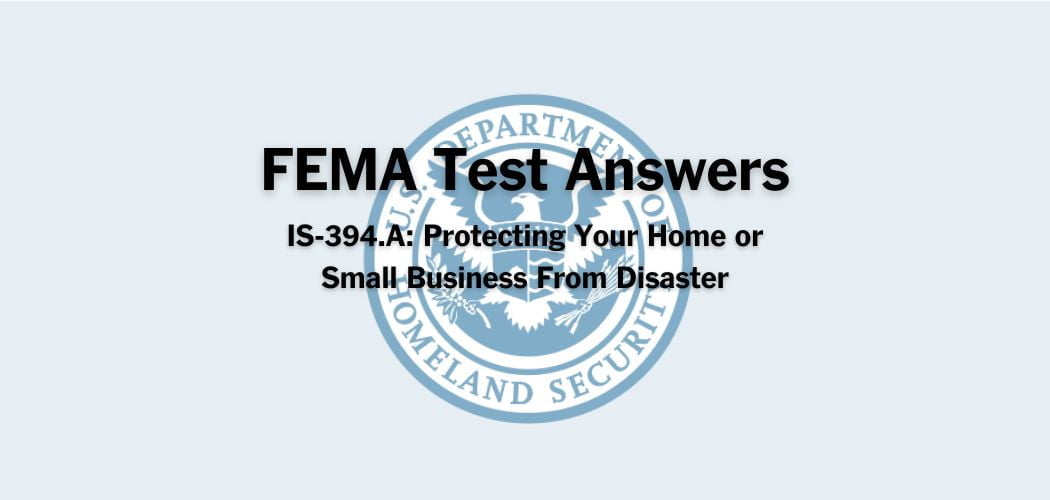Overview: The FEMA IS-1119 course was published on 3/17/2020 to provide information to individuals interested in Letters of Map Change (LOMCs) with a focus on Conditional Letters of Map Amendment (CLOMAs); Letters of Map Amendment (LOMAs); Conditional Letters of Map Revision—Based on Fill (CLOMR-Fs); and Letters of Map Revision—Based on Fill (LOMR-Fs) on the applicant, community floodplain administrator, licensed professional, and FEMA levels.
PREREQUISITE: IS:273 HOW TO READ A FLOOD INSURANCE RATE MAP (FIRM)
FEMA IS-1119 test answers
Each time that this test is loaded, you will receive a unique set of questions and answers. The test questions are scrambled to protect the integrity of the exam.
Question 1. One way to find the general location of a property on an effective Flood Insurance Rate Map (FIRM) is to:
A. check the title boxes on all map panels for the street address.
B. refer to features, such as major roads or city limits on the appropriate Flood Insurance Rate Map (FIRM) panel.✅
C. refer to the Map Index to find the street address.
D. search for the flood insurance risk zone designation on the appropriate Flood Insurance Rate Map (FIRM) panel.
Question 2. A Letter of Map Revision–Based on Fill (LOMR-F) application is submitted for a two-story house with a full basement on a lot that has been elevated with fill 2 feet above the Base Flood Elevation (BFE). What potential violation of floodplain management regulations can be identified in this application?
A. The home’s heating, ventilating, and air conditioning (HVAC); electrical; and plumbing systems are not protected from flooding.
B. The lowest floor elevation (LFE) is below the Base Flood Elevation (BFE).
C. The basement has not been sufficiently floodproofed.
D. The lot was backfilled after the structure was constructed.✅
Question 3. The community Floodplain Administrator’s (FPA’s) roles and responsibilities, in relation to Letters of Map Change (LOMCs), may include:
A. obtaining flood insurance by the deadline when a lender provides notification of the mandatory purchase requirement.
B. issuing a violation memo to the community if the structure is not compliant with minimum National Flood Insurance Program (NFIP) Floodplain Management regulations.
C. understanding mail, Online Letter of Map Change (LOMC), and electronic Letter of Map Amendment (eLOMA) application submission requirements.
D. reviewing Letter of Map Change (LOMC) applications to ensure that projects are compliant with local ordinances.✅
Question 4. A licensed professional’s roles and responsibilities, in relation to Letters of Map Change (LOMCs), may include:
A. understanding how regulations apply to Letter of Map Change (LOMC) proposals.
B. obtaining the services of a licensed professional.
C. developing Base Flood Elevations (BFEs) for unnumbered (or Approximate) Zone A areas.✅
D. evaluating compliance with minimum National Flood Insurance Program (NFIP) Floodplain Management regulations.
Question 5. The Letter of Map Change (LOMC) applicant’s roles and responsibilities may include:
A. completing the Elevation Certificate (EC) or Elevation Form in the MT-1 application.
B. coordinating with the community to resolve violations.
C. ensuring all permits have been obtained before Letter of Map Change (LOMC) application submittal.✅
D. consulting with community officials.
Question 6. If a proposed or existing project or structure is compliant with local floodplain management regulations, who is responsible for reviewing and signing the Community Acknowledgement Form for Conditional Letters of Map Revision–Based on Fill (CLOMR-Fs) and Letters of Map Revision–Based on Fill (LOMR-Fs) applications, or for Letters of Map Amendment (LOMA) requests that involve an area that was inadvertently included within the floodway?
A. The lender
B. Elected officials
C. The community Floodplain Administrator (FPA)
D. A licensed professional✅
Question 7. Who is responsible for enforcement action against violators of local floodplain management ordinances?
A. The chief of police
B. Elected officials
C. The community Floodplain Administrator (FPA)✅
D. National Flood Insurance Program (NFIP) Coordinators
Question 8. Which signed form indicates to FEMA that all necessary permits were obtained, the Letter of Map Change (LOMC) applicant is in compliance with local ordinances and NFIP regulations, and that the development is or will be reasonably safe from flooding?
A. Elevation Form
B. Elevation Certificate (EC)
C. Zone V Certificate
D. Community Acknowledgement Form✅
Question 9. Who serves as the point-of-contact with other jurisdictions, the state, and the federal government on Letter of Map Change (LOMC) applications?
A. The community Floodplain Administrator (FPA)✅
B. A real estate developer
C. A licensed professional
D. National Flood Insurance Program (NFIP) Coordinators
Question 10. My development is shown in a Special Flood Hazard Area (SFHA), but I elevated the portion of the lot where the development is located above the Base Flood Elevation (BFE) using appropriately compacted fill. Which is the appropriate document to request?
A. Letter of Map Revision (LOMR)
B. Letter of Map Amendment (LOMA)
C. Conditional Letter of Map Amendment (CLOMA)
D. Letter of Map Revision—Based on Fill (LOMR-F)✅
Question 11. The community Floodplain Administrator’s (FPA’s) roles and responsibilities, in relation to Letters of Map Change (LOMCs), may include:
A. completing the Elevation Certificate (EC) or Elevation Form in the MT-1 application.
B. coordinating with the community to resolve violations.
C. ensuring all permits have been obtained before Letter of Map Change (LOMC) application submittal.✅
D. consulting with community officials.
Question 12. A licensed professional can advise a property owner on whether a metes and bounds description or information on the structures _____ would be the best way to meet his or her Letter of Map Change (LOMC) application needs.
A. highest adjacent grade (HAG)✅
B. Base Flood Elevation (BFE)
C. lowest floor elevation (LFE)
D. lowest adjacent grade (LAG)
Question 13. A licensed professional’s roles and responsibilities, in relation to Letters of Map Change (LOMCs), may include:
A. using the status of the structure or lot to select the appropriate map change/amendment process.
B. conducting surveys to collect elevation data and/or metes and bounds descriptions.
C. maintaining and updating flood data and maps to reflect Letters of Map Amendment (LOMAs) and Letters of Map Revision–Based on Fill (LOMR-Fs).
D. reviewing, requesting additional supporting information, or approving or denying Letter of Map Change (LOMC) applications.✅
Question 14. What is one of the most common reasons for submitting a Letter of Map Amendment (LOMA) application?
A. Jurisdictional boundaries have changed
B. To more accurately depict the flood risk associated with a structure or property✅
C. To allow construction seaward of a primary frontal dune
D. To better align with existing road and highways maps
Question 15. The community Floodplain Administrator’s (FPA’s) roles and responsibilities, in relation to Letters of Map Change (LOMCs), may include:
A. understanding how regulations apply to Letter of Map Change (LOMC) proposals.✅
B. obtaining the services of a licensed professional.
C. developing Base Flood Elevations (BFEs) for unnumbered (or Approximate) Zone A areas.
D. evaluating compliance with minimum National Flood Insurance Program (NFIP) Floodplain Management regulations.
Question 16. Work on culverts in a floodway has changed the Base Flood Elevation (BFE). Which is the appropriate document to request?
A. Letter of Map Revision (LOMR)✅
B. Letter of Map Amendment (LOMA)
C. Conditional Letter of Map Amendment (CLOMA)
D. Letter of Map Revision—Based on Fill (LOMR-F)
Question 17. If the legal description is inadequate or only a portion of a lot is being requested to be removed, a _____ will be required.
A. block and plat description
B. metes and bounds description✅
C. hydrology and hydraulic study
D. photograph of the lot
Question 18. What would be the appropriate determination for a Letter of Map Change (LOMC) application that references a vertical datum that is different than what is referenced on the Flood Insurance Rate Map (FIRM)?
A. Denied
B. Approved
C. Conditionally approved
D. More information is required to make a determination✅
Question 19. One way a community Floodplain Administrator (FPA) may obtain a copy of a Letter of Map Change (LOMC) is to:
A. contact the public works department in the community.
B. contact the public library.
C. use the Community Search process or the National Flood Hazard Layer (NFHL) viewer on the FEMA Map Service Center (MSC) website.✅
D. use the Search function on the https://www.floodsmart.gov/ website.
Question 20. What is the first step to locate a property on an effective Flood Insurance Rate Map (FIRM)?
A. Find the correct map panel.✅
B. Find the general location.
C. Identify the flood insurance risk zone of the property.
D. Find the specific location of the property.
Question 21. MT-EZ or MT-1 applications require both the Base Flood Elevation (BFE) and:
A. Light Detection and Ranging (LiDAR) or other Digital Elevation Models (DEMs) to support the Base Flood Elevation (BFE).
B. new hydrology and hydraulics studies to support the Base Flood Elevation (BFE).
C. Geographic Information Systems (GIS) maps to support the Base Flood Elevation (BFE).
D. the source for the Base Flood Elevation (BFE) data.✅
Question 22. A structure is determined to be in the Special Flood Hazard Area (SFHA) after an updated Flood Insurance Rate Map (FIRM) panel superseded and invalidated the Letter of Map Amendment (LOMA) or Letter of Map Revision–Based on Fill (LOMR-F). The property owner will be required to carry flood insurance protection if:
A. the value of the structure is assessed at more than $100,000.
B. the mortgage is from a federal lender or federally-regulated lending institution.✅
C. the structure has been renovated or expanded.
D. the mortgage is paid in full.
Question 23. After a Letter of Map Amendment (LOMA) or Letter of Map Revision–Based on Fill (LOMR-F) is obtained, a property owner must consider the risk associated with low probability, but high consequence events such as:
A. heavy rains that result in shallow flooding due to ponding.
B. the failure of a dam or flood-control structure.
C. flash flooding due to a heavy rainstorm outside of the Special Flood Hazard Area (SFHA).
D. deep or high-velocity flooding within the Special Flood Hazard Area (SFHA).✅
Question 24. Who must certify the accuracy of the elevation information on an Elevation Certificate (EC) or the Elevation Form in the MT-1 application?
A. The community Floodplain Administrator (FPA)
B. FEMA reviewers
C. A licensed land surveyor, registered professional engineer, or architect (depending on state laws)✅
D. The mortgage lender
Question 25. Why would a property owner or developer want to consult with the community Floodplain Administrator (FPA) as early as possible when considering any floodplain development?
A. The community Floodplain Administrator (FPA) can complete the Letter of Map Change (LOMC) application for them.
B. The community Floodplain Administrator (FPA) can explain the local floodplain development ordinances which apply to the identified flood zone and identify compliant approaches to development.✅
C. The community Floodplain Administrator (FPA) can expedite the review and approval of the Letter of Map Change (LOMC) application.
D. The community Floodplain Administrator (FPA) can negotiate directly with the National Flood Insurance Program (NFIP) for a lower flood insurance policy rate for the property owner.
Question 26. Who may be called upon to locate existing Base Flood Elevation (BFE) data, develop initial BFE data, or perform hydraulic and hydrologic analyses and other studies to support Letter of Map Change (LOMC) applications in Approximate A Zones?
A. Licensed land surveyors
B. Registered professional engineers✅
C. Licensed architects
D. National Flood Insurance Program (NFIP) Coordinators
Question 27. Which Letter of Map Change (LOMC) is a letter from FEMA officially revising the current NFIP map to show changes to floodplains, regulatory floodways, or flood elevations?
A. Letter of Map Revision (LOMR)✅
B. Letter of Map Amendment (LOMA)
C. Conditional Letter of Map Amendment (CLOMA)
D. Letter of Map Revision—Based on Fill (LOMR-F)
Question 28. Who can help a Letter of Map Change (LOMC) applicant locate the property on a Flood Insurance Rate Map (FIRM) and determine the Base Flood Elevation (BFE)?
A. The community Floodplain Administrator (FPA)✅
B. A real estate developer
C. A licensed professional
D. The FEMA Regional Office
Question 29. You may be required to carry flood insurance if you invalidate your Letter of Map Amendment (LOMA) or Letter of Map Revision–Based on Fill (LOMR-F) by:
A. adding sheds or other outbuildings to the area covered by the Letter of Map Amendment (LOMA) or Letter of Map Revision–Based on Fill (LOMR-F).
B. adding more permitted fill to the area covered by the Letter of Map Amendment (LOMA) or Letter of Map Revision–Based on Fill (LOMR-F).✅
C. adding a permitted retaining wall to the area covered by the Letter of Map Amendment (LOMA) or Letter of Map Revision–Based on Fill (LOMR-F).
D. expanding a structure to a portion of the lot not included in the Letter of Map Amendment (LOMA) or Letter of Map Revision–Based on Fill (LOMR-F).
Question 30. A Letter of Map Revision–Based on Fill (LOMR-F) application is submitted for a 6-inch slab-on-grade foundation elevated on 1 foot of fill in Zone AO. The Flood Insurance Rate Map (FIRM) does not show a base flood depth number for the flood zone. What potential violation of floodplain management regulations might be identified in this application if there is no base flood depth number on the Flood Insurance Rate Map (FIRM)?
A. The lowest floor cannot be less than 2 feet above the highest adjacent grade (HAG).
B. The lowest floor elevation (LFE) must equal or exceed Base Flood Elevation (BFE).✅
C. The highest adjacent grade (HAG) must be above the Base Flood Elevation (BFE).
D. Construction is not permitted in Zone AO.
Question 31. Property owners require the services of licensed professionals to _____ Letter of Map Change (LOMC) applications.
A. review, request additional supporting information, or approve or deny
B. compile the necessary data and documentation to complete✅
C. create structural plans to attach to
D. understand how regulations apply to
Question 32. Once a property owner has received a Letter of Map Amendment (LOMA) or Letter of Map Revision–Based on Fill (LOMR-F):
A. the mortgage lender may still require flood insurance.✅
B. there is no need to purchase flood insurance because there is no longer any risk of flooding.
C. the owner must purchase a Preferred Risk policy.
D. flood insurance is no longer available because the property is outside of the Special Flood Hazard Area (SFHA).
Question 33. It is necessary to specify the latitude and longitude of the ___ for an MT-EZ or MT-1 application.
A. most downstream end of a structure or property
B. most upstream end of a structure or property✅
C. the lowest lot elevation (LLE) or lowest adjacent grade (LAG) elevation
D. the lowest lot elevation (LLE) or highest adjacent grade (HAG) elevation
Question 34. The owner of a structure in Zone AO that has received a Letter of Map Amendment (LOMA) or Letter of Map Revision–Based on Fill (LOMR-F) may wish to maintain flood insurance because of ____ events like heavy rains that produce shallow flooding and ponding.
A. low probability/high consequence✅
B. no risk/no consequence
C. high probability/high consequence
D. high probability/low consequence
Question 35. A licensed professional’s roles and responsibilities, in relation to Letters of Map Change (LOMCs), may include:
A. completing the Elevation Certificate (EC) or Elevation Form in the MT-1 application.✅
B. coordinating with the community to resolve violations.
C. ensuring all permits have been obtained before Letter of Map Change (LOMC) application submittal.
D. consulting with community officials.
Question 36. A Letter of Map Revision–Based on Fill (LOMR-F) application is submitted for a sloping site located in the floodway. The developer received a permit to place fill to level the site so that the lowest lot elevation (LLE) is above the Base Flood Elevation (BFE). However, recent seasonal rainfall events that are normal for this region have resulted in water levels upstream of the site higher than the BFEs shown on the Flood Insurance Rate Map (FIRM). What potential violation of floodplain management regulations can be identified in this application?
A. Construction of retaining walls in the floodway is prohibited.
B. Fill in the floodway that causes a measurable increase in the Base Flood Elevation (BFE).✅
C. Fill in the floodway is prohibited.
D. The highest natural ground must be above the Base Flood Elevation (BFE) in a regulated floodway.
Question 37. The Letter of Map Change (LOMC) applicant’s roles and responsibilities may include:
A. understanding how regulations apply to Letter of Map Change (LOMC) proposals.
B. obtaining the services of the appropriate licensed professional(s).
C. developing Base Flood Elevations (BFEs) for unnumbered (or Approximate) Zone A areas.
D. evaluating compliance with minimum National Flood Insurance Program (NFIP) Floodplain Management regulations.✅
Question 38. Letter of Map Change (LOMC) requests are not eligible for submission via the electronic Letter of Map Amendment (eLOMA) Mapping Information Platform (MIP) if:
A. the property is more than 50 acres or 55 lots.
B. the developer and not the property owner is the applicant.
C. fill has been placed or will be placed to raise the ground elevation.✅
D. a previous request has been denied.
Question 39. FEMA’s role and responsibilities, in relation to Letters of Map Change (LOMCs), may include:
A. using the status of the structure or lot to select the appropriate map change/amendment process.
B. conducting surveys to collect elevation data and/or metes and bounds descriptions.
C. maintaining and updating flood data and maps to reflect Letters of Map Amendment (LOMAs) and Letters of Map Revision–Based on Fill (LOMR-Fs).
D. reviewing, approving or denying, or requesting additional data to support a Letter of Map Change (LOMC) application.✅
Question 40. If a project is not compliant with local floodplain management ordinances, the community official may:
A. request that local floodplain management ordinances be changed so that the project is compliant.
B. sign the form and alert the Regional National Flood Insurance Program (NFIP) Coordinator as to the issue.
C. refuse to sign the form, or sign the form and state that the project is not compliant.✅
D. Initiate legal action against the licensed professionals who helped to prepare the Letter of Map Amendment (LOMA) application.
Question 41. You may be required to carry flood insurance if you invalidate your Letter of Map Amendment (LOMA) or Letter of Map Revision–Based on Fill (LOMR-F) by _____ the area covered by the LOMA.
A. adding more permitted fill to
B. excavating land which allows flood waters to encroach upon✅
C. adding sheds or other outbuildings to
D. adding a permitted retaining wall to
Question 42. My house was inadvertently included in a Special Flood Hazard Area (SFHA), but the structure is actually built on natural high ground. Which is the appropriate document to request?
A. Letter of Map Revision (LOMR)
B. Letter of Map Amendment (LOMA)✅
C. Conditional Letter of Map Amendment (CLOMA)
D. Letter of Map Revision—Based on Fill (LOMR-F)



